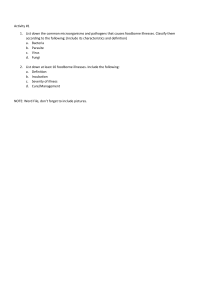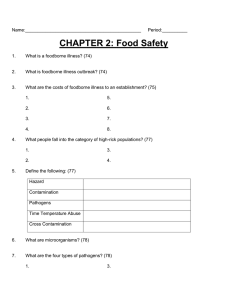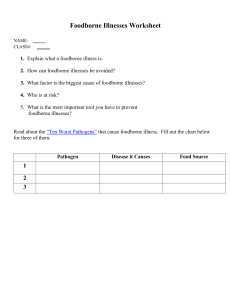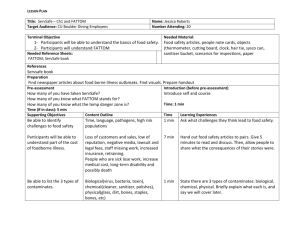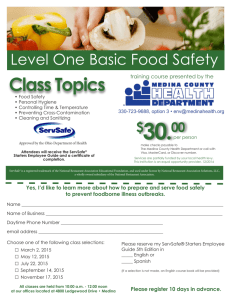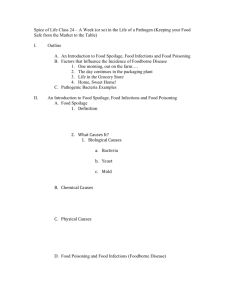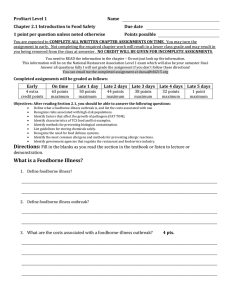Culinary Arts Planning Guide Fall Week 2
advertisement
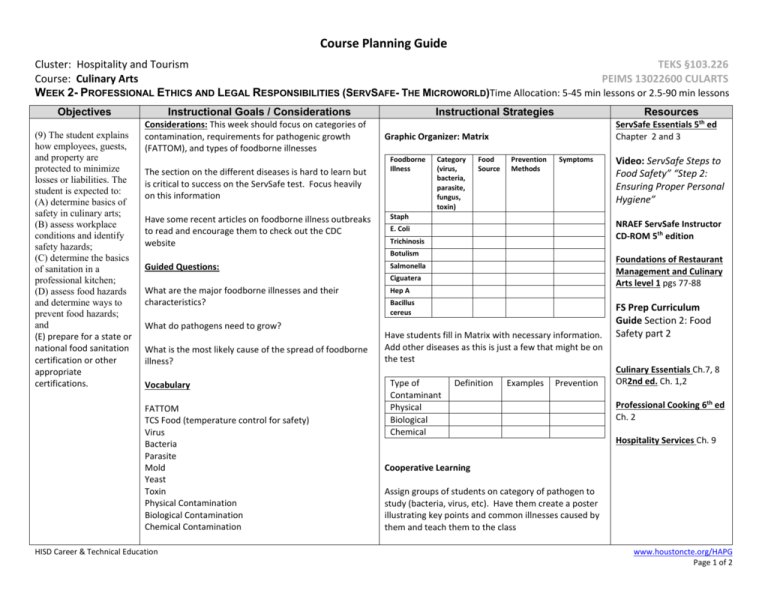
Course Planning Guide Cluster: Hospitality and Tourism TEKS §103.226 Course: Culinary Arts PEIMS 13022600 CULARTS WEEK 2- PROFESSIONAL ETHICS AND LEGAL RESPONSIBILITIES (SERVSAFE- THE MICROWORLD)Time Allocation: 5-45 min lessons or 2.5-90 min lessons Objectives (9) The student explains how employees, guests, and property are protected to minimize losses or liabilities. The student is expected to: (A) determine basics of safety in culinary arts; (B) assess workplace conditions and identify safety hazards; (C) determine the basics of sanitation in a professional kitchen; (D) assess food hazards and determine ways to prevent food hazards; and (E) prepare for a state or national food sanitation certification or other appropriate certifications. Instructional Goals / Considerations Considerations: This week should focus on categories of contamination, requirements for pathogenic growth (FATTOM), and types of foodborne illnesses The section on the different diseases is hard to learn but is critical to success on the ServSafe test. Focus heavily on this information Have some recent articles on foodborne illness outbreaks to read and encourage them to check out the CDC website Instructional Strategies Resources ServSafe Essentials 5th ed Chapter 2 and 3 Graphic Organizer: Matrix Foodborne Illness Category (virus, bacteria, parasite, fungus, toxin) Food Source Prevention Methods Symptoms Staph NRAEF ServSafe Instructor CD-ROM 5th edition E. Coli Trichinosis Botulism Guided Questions: Foundations of Restaurant Management and Culinary Arts level 1 pgs 77-88 Salmonella Ciguatera What are the major foodborne illnesses and their characteristics? What do pathogens need to grow? What is the most likely cause of the spread of foodborne illness? Vocabulary FATTOM TCS Food (temperature control for safety) Virus Bacteria Parasite Mold Yeast Toxin Physical Contamination Biological Contamination Chemical Contamination HISD Career & Technical Education Hep A Bacillus cereus Have students fill in Matrix with necessary information. Add other diseases as this is just a few that might be on the test Type of Contaminant Physical Biological Chemical Video: ServSafe Steps to Food Safety” “Step 2: Ensuring Proper Personal Hygiene” Definition Examples Prevention FS Prep Curriculum Guide Section 2: Food Safety part 2 Culinary Essentials Ch.7, 8 OR2nd ed. Ch. 1,2 Professional Cooking 6th ed Ch. 2 Hospitality Services Ch. 9 Cooperative Learning Assign groups of students on category of pathogen to study (bacteria, virus, etc). Have them create a poster illustrating key points and common illnesses caused by them and teach them to the class www.houstoncte.org/HAPG Page 1 of 2 Course Planning Guide Cluster: Hospitality and Tourism Course: Culinary Arts TEKS §103.226 PEIMS 13022600 CULARTS Lab: Bacteria Experiment FATTOM Food- pathogens grow best in foods that are high energy like carbohydrates and proteins Acidity- pathogens grow best in foods with little or no acidity Temperature- pathogens grow well between 41F and 135F Time- pathogens need time to grow. It takes 4 hours for levels to become high enough to make someone sick Oxygen- some pathogens need oxygen to grow, and some grow when oxygen isn’t there (like in cooked rice) Moisture- pathogens need moisture to grow so they are commonly found in foods with high moisture content (melons, tomatoes) Have students swab areas of kitchen or school or under their fingernails and place swab on agar. Seal in a petri dish and place in incubators. Take a field trip to a biology lab to use microscopes to watch it grow. Performance Objectives: The student will be able to: HISD Career & Technical Education Identify common foodborne illnesses, their causes, and prevention methods www.houstoncte.org/HAPG Page 2 of 2
